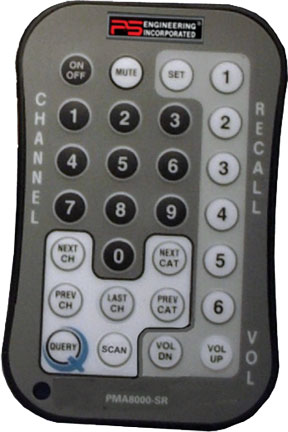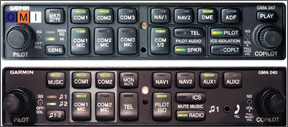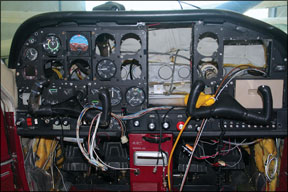In the old days, audio panels were simple devices that allowed the use of headphones and handled switching and separation of the communications radios. These days, audio panels are audio control hubs handling radios, patching through traffic and terrain alerts, supplying the intercom and controlling cabin entertainment. Its not so important to choose one brand over the other. Its all in the installation and how fancy you want to get with entertainment. If we can offer a single piece of advice on any audio system upgrade its this: don’t skimp on the wiring. In the high-stakes game of cabin audio, shortcuts are unacceptable. Forget about chopping the connector from an old Narco CP135 audio panel and wiring up the new hardware. The same is true for most older intercom systems. This will drive up the cost-$4000 for the parts and labor isn’t unreasonable-but thats what it takes for crystal-clear sound.
Garmin reliablity
Weve always been impressed with the feel and look of the bezel, rotary knobs and the selector buttons on the Garmin panels. They offer a positive, high-quality feel. The green LED annunciator lighting built into each button tells you what is active at a glance.
The GMA340 has been a hugely popular choice in panels, especially during GNS 400- and 500-series upgrades. The GMA340 has an integral intercom that supports up to six seats, with independent volume and squelch control for pilot and copilot (all passenger volume is on a single control), and there’s isolation for the pilot or both front seats. It supports three comm radios (the extra could be for a UHF radio or a cell phone), two inputs for aural warnings, two entertainment inputs and an integral marker beacon with lights.
In our view, the GMA340 is a capable and reliable panel, but not the best for entertainment. Whenever someone speaks on the intercom or there’s a radio transmission, the music automatically mutes. This can be a nuisance with chatty passengers.
There’s a modification available that provides a mute inhibit feature, but it requires a panel-mounted switch and extra wiring. Discuss this with your installing shop beforehand, as adding this feature when its all back together is far from practical.
Upgrading to the GMA347 (see May 2006 Aviation Consumer) adds an automatic squelch (with reversion to manual squelch), a full-duplex cell-phone interface and a digital voice recorder. The cell phone interface allows private phone calls by isolating the intercom station making the call, and the recorder can replay the last

2.5 minutes of communications.
The GMA347 has provisions for five unswitched inputs which should be plenty for traffic, terrain, autopilot and other audio-alerting interfaces. There’s a remote module that stores pertinent installation settings so the unit can be replaced without having to program the new one. Several shops told us theyre not crazy about the installation effort for a GMA347 given the need for the remote module and the initial programming.
The GMS347 is essentially a panel-mounted version of the remote GMA37 thats used in the G1000 suite. The GMA347 seems to lag in popularity compared to the GMA340.
The newly-introduced, four-place GMA240 is a non-TSO panel for LSA and Experimental aircraft. Its focused on basic radio switching (no ADF or DME) and cockpit entertainment. It sports an integrated music volume control, music source switch (for dual entertainment sources) and music on/off button. There’s also a bezel-mounted input jack for an iPod portable GPS with XM Radio. The bezel jack can also be used for cell phones. The unit accepts three unswitched inputs, which is plenty for most LSAs. Priced at $895, we feel the GMA240 is a good value for aircraft that can use the system.
PS Engineering ingenuity
These folks have an audio panel for nearly any application, from basic to integrated satellite radio and built-in MP3 players. With a proven record for innovation and quality, PS Engineering has been the choice for big-name integrated flight decks such as the Avidyne Entegra Release Nine and L-3s SmartDeck. Many of the panels

in the PS Engineering line can directly replace existing units from other brands.
The flagship PMA8000B was our top pick when we reviewed it in the June 2006 issue, given its long list of features for a price of $1895. Since then, there have been more features added as standard, such as a readback recorder. This used to be a $130 premium. Since many owners would automatically select the GMA340 to complement a newly installed GNS430 or 530, PS Engineering played hardball and designed the PM8000 to slide into a GMA340 installation. PS Engineering purposely designed the face to complement other products in the Garmin line.
The PM8000B is loaded with features and functions. There’s an integral six-place IntelliVox stereo intercom (computer-controlled squelch that precisely opens and closes the squelch without clipping a single syllable), dual coms, dual navs, ADF (there’s no DME switch and we would like to see it rather than the ADF) and marker beacon.
The dual-channel entertainment system is where the PM8000-series really shines. Dedicated function keys make it easier for the pilot to route the entertainment sources to the passenger seats while controlling whos isolated or muted from the intercom. There’s also an input jack located on the front bezel thats smart enough to self-configure for cellular phone or entertainment input source.
The $2095 PMA8000B-MP3 adds a built-in MP3 player with 1GB of memory (approximately 250 songs). We think this is a hugely convenient option to a portable player in the cockpit, since there’s no patch cable required to plug into a panel jack. All functions including MP3 volume are controlled from the bezel. The MP3 music files are loaded to the panel using a portable Flash drive or a computer. There’s even voice prompting of “Transfer complete” when the download is finished.
The PMA8000-SR panel has an integral SIRIUS Satellite Radio system. Impressively, there are no remote boxes to mount in the tail or nose. Instead, the receiver is completely contained inside the panel and the system is commanded with a remote control. There’s also a glareshield-mounted satellite antenna. SIRIUS Radio volume and channel selection can be controlled via the front bezel or on a remote. When you command a channel change, a voice is annunciated stating the channel selection.
Its important to note that as with other SIRIUS receivers, flying over some heavily populated areas may cause the signal to drop out due to interference from ground-based repeaters. The PMA8000-SR is priced at $2590. We think this is a decent alternative to using a portable SIRIUS radio since there are no stray wires to deal with.
The $1595 PMA7000B offers IntelliVox, a three-com transceiver capability, which can also be used for duplex cellular phone, and a split com that allows pilot and copilot to each transmit on different radios. It accepts four unswitched inputs, has crew and pilot isolation, and marker beacon.

The PMA7000B can directly replace an existing Bendix/King KMA24 audio panel, of which there are many still in service. Since the PM7000B has integral six-place intercom additional wiring is needed, but where the existing wiring is in good condition with proper shielding that still could be a substantial savings in labor. This unit can be expanded for 10 passenger seats through the IntelliPax expansion module.
The $2399 PMA7000CD adds a remote-mounted CD/MP3 player. The remote disk player is a PCD7100, but its controlled through the PMA7000 (the ADF and DME selector buttons were dropped to make way for the controls).
The budget-focused, $995 PMA6000-series was the first audio panel introduced by PS Engineering, and there still many of these panels in service. Think of the PMA6000 as a switching panel with a built-in PM1000 intercom (a popular stand-alone PS intercom). The PMA6000M-S is a model that has a marker beacon and stereo intercom. A PM7000B can directly replace a 6000 if youre moving up.
For basic switching and ICS functions worthy for use in LSA and basic experimentals (the unit is designed with tandem-place aircraft in mind)
The $849 PMA4000 is ideal for tight spaces and simpler aircraft since its available in a 2-inch instrument hole. It has a four-place IntelliVox intercom and, for tandem applications, a remote volume control that can be mounted by the other seat.
For experimental applications, the non-TSO PMA9000EX controls two coms and two navs, and has built-in, 1 GB MP3 player and a Bluetooth connection for cell phones. It has a graphical LCD display that PS Engineering calls “JAG” for Just a Glance. The display shows which song is being played or how the panel is configured. Music files are loaded into the unit through the bezel jack using a USB adapter cable. The 9000EX has IntelliVox stereo intercom for six seats, marker beacon, internal recorder, and is plug compatible with the Garmin GMA340. The PMA900EX costs $2295.
All PMA8000 models offer a “Karaoke mode” where you can talk over the music. All PS Engineering panels can be configured for “transmit swap” where a yoke or panel-mounted switch can be connected to switch com transmitters with the push of a button. don’t assume your shop will install this option without you requesting it.

There are so many functions in these panels that the bezel is fairly busy, and weve witnessed new owners struggle with setting up the cabin entertainment functions. PS Engineering attempts to solve this issue with what they call “Virtual Tech Support” or VTS (stock in all PM8000 units). This is voice prompting that aids in setting up the various entertainment distribution options. PS Engineering says you wont need the pilot guide, but were not so sure.
Other Options
The Honeywell KMA28 is a PS Engineering PMA7000 wearing Bendix/King colors and a higher price tag. Buy the PS version. The classic KMA24H series, which contains a hot-mic intercom but no marker beacon, is available for helicopter applications. The KMA24H has always been a popular unit for rotor wing applications and its available today, but for the impressive price of $2549.
The Bendix/King Crown Series model KA134 panel offers basic switching, with no intercom functions. It has speaker operation, dual coms, dual navs, ADF and DME, and has marker audio input. Its compact, measuring under an inch high, but pricey at $2573.
The VAL Avionics AP100 is a basic switching panel that occupies only one inch of panel height. It doesnt have intercom functions, but it does have the ability to control two coms, two navs, four unswitched audio inputs, and has both a failsafe mode and has a speaker amplifier. Its dirt cheap at $495.
Conclusion
If youre after good-sounding, reliable communications, wrestling over any particular model isn’t nearly as important as a quality installation. You can expect a four-place audio system to run every bit of $4000 when you factor in new wiring and new audio jack housings neatly installed in the interior.
If entertainment options are important to you, it pays to do your homework and work closely with the shop to get the configuration you expect-including a convenient spot on the panel to mount the controls. PS Engineerings PM8000-series is our general pick, with the PMA8000B-MP3 our hands-down choice for no-hassle music on the fly. Sweeter yet, these units can replace an existing GMA340. If your plans include the occasional iPod or MP3 plug-in, there’s nothing wrong with going with a GMA340 or PMA7000. If you want old-fashioned manual control over intercom squelch, the GMA340 is rugged, reliable and proven.
And lastly, don’t venture into a new audio install with unresolved charging system and electrical issues. You and your shop alike will be frustrated when the audio doesnt sound as good as it should.


